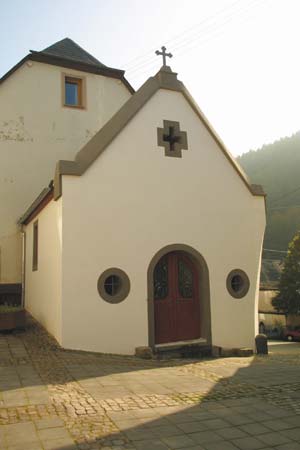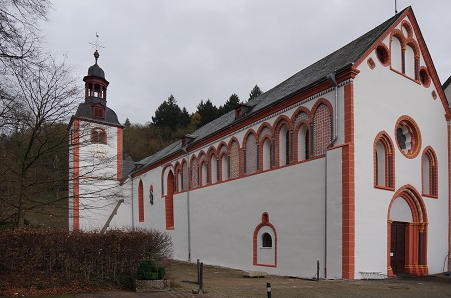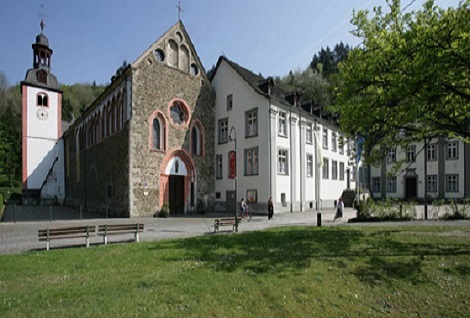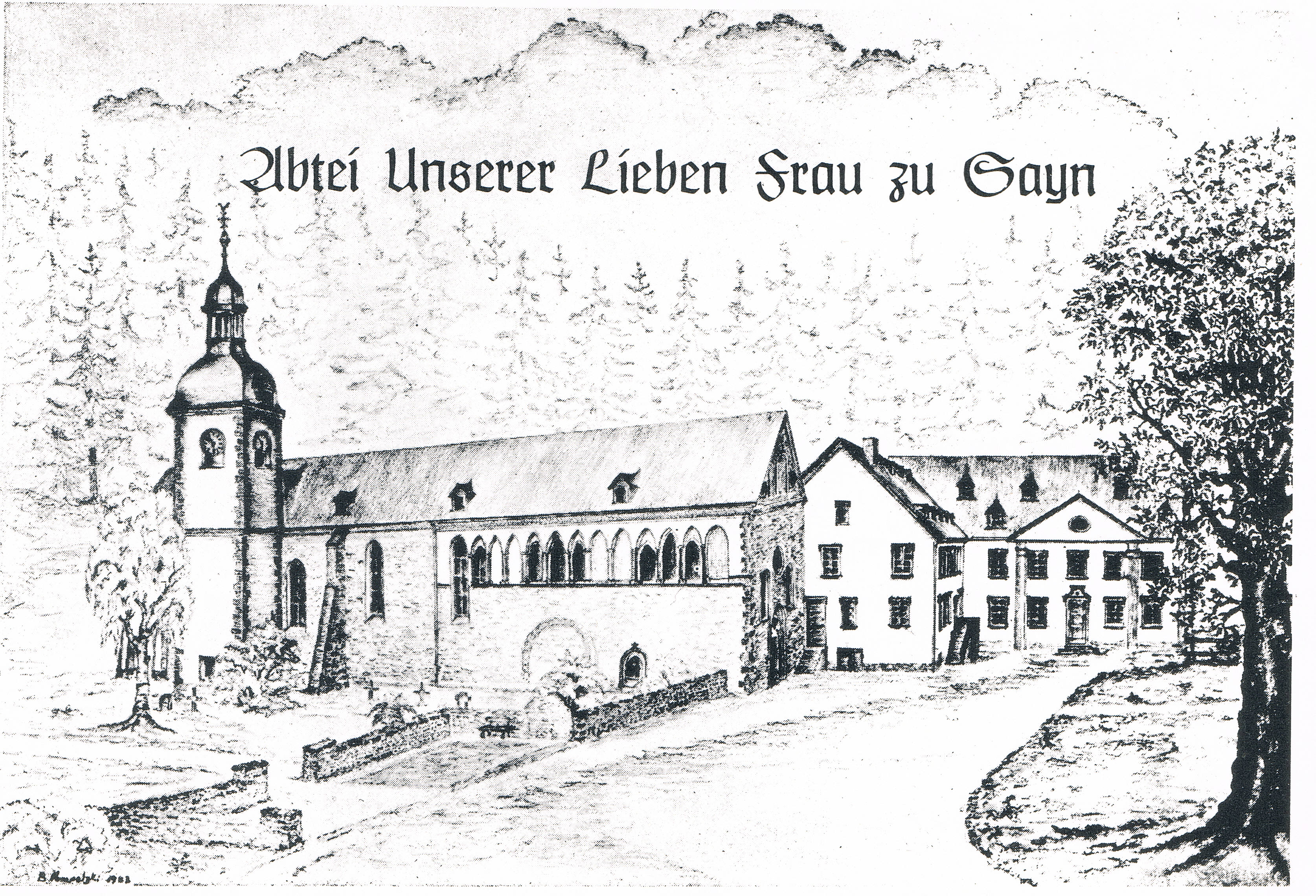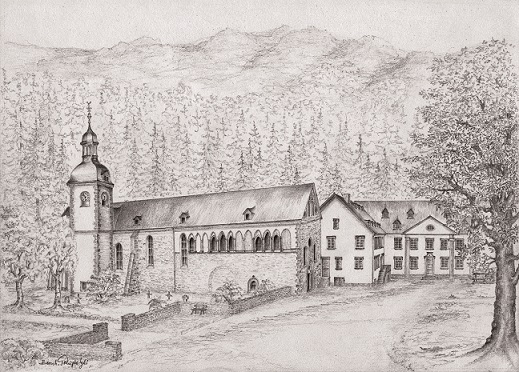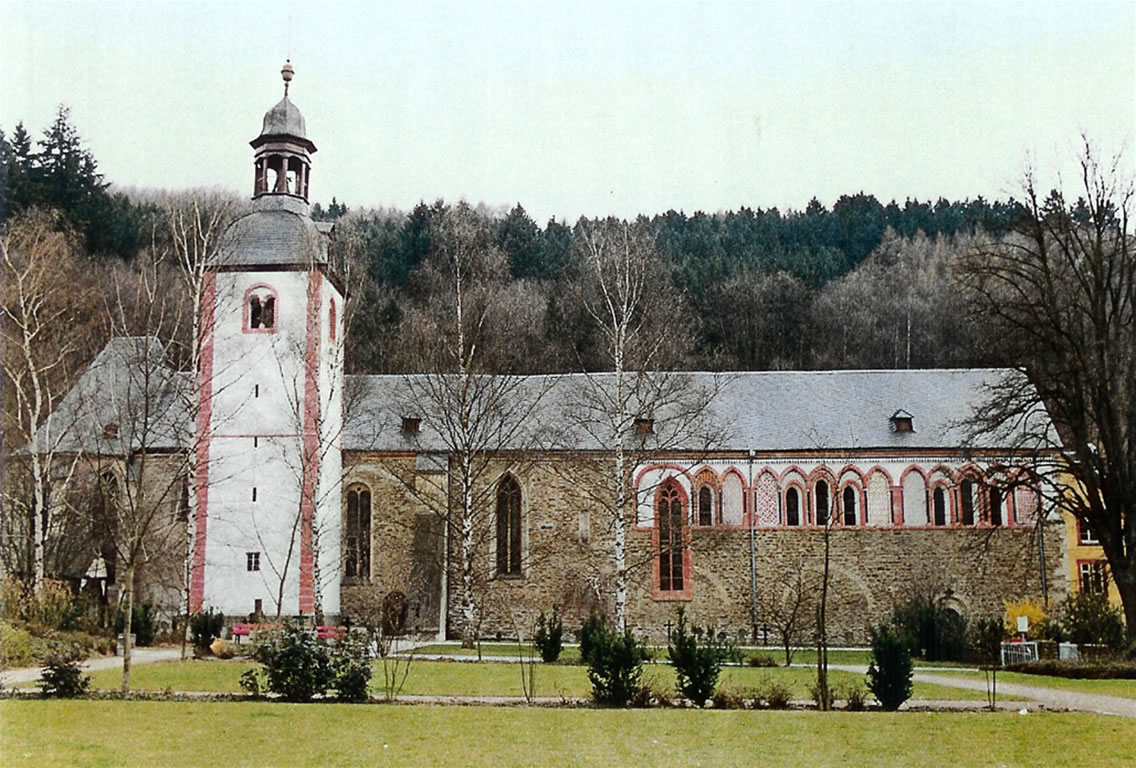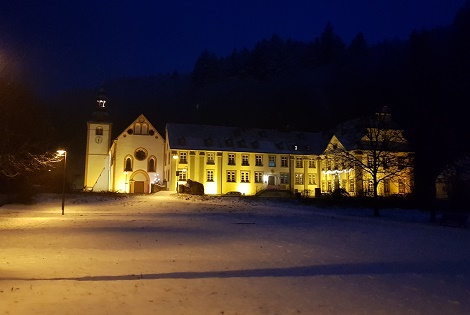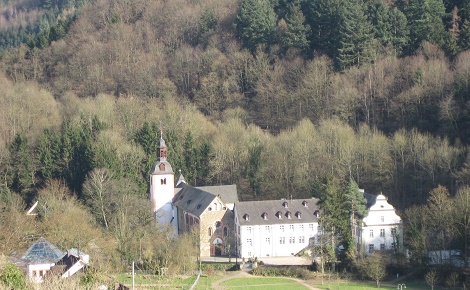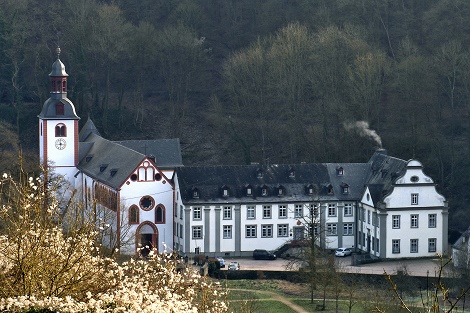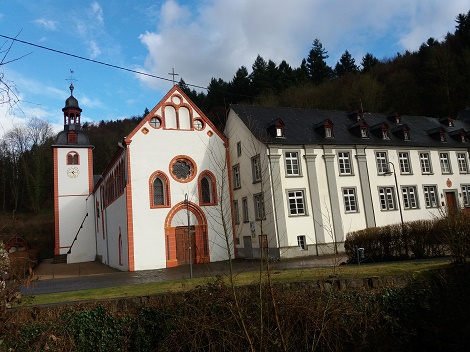The Sebastian Chapel in abbey street
After the plague dedicated to Saint Sebastian and Saint Rochus (1670)
Regular services are held not only in the abbey church in Sayn, but also in the palace chapel and in the chapel dedicated to Saint Sebastian in the small square in Abbey street, in the middle of which a slim wooden cross as high as a house and protected by a slate roof can be seen. The chapel set against the gable of the former parish house was built by the parish of Sayn to fulfil a vow made during the plague in the 1660s.
On 29th August 1664 the Elector Karl Kaspar von der Leyen warned the Koblenz population against taking people in from towns already affected. In August 1665 the first case of the plague was recorded in Cologne; two months later a man came from Trier to Ehrenbreitstein, where he died of symptoms resembling those of the “black death”. Koblenz and the surrounding region were in great panic. The people took shelter in prayer and atonement. It was attempted to close off areas in which the plague was thought to be. There was an unusual preoccupation with cleanliness. The surrounding regions may have conducted similar measures as noted in the town council minutes of Koblenz [1] to combat the plague.
In Sayn the Premonstratensian Tilman Baldems was the parson the abbey there. For spiritual guidance he stayed with his parish while other members of his convent avoided places hit by the plague. In Bendorf the Premonstratensian Willibrord Römer worked with the sick.[2] In the orally passed on account it is stated in the stick that today is still there in the Abbey street and that then was outside of the wall and half way to the abbey the consecrated bread was put daily which Baldems picked up in order to celebrate holy mass. He too was infected by the dreadful pestilence. When he realised that he would have to die, he asked the people of Sayn, to set up a cross at that place, where in the time of crisis the holy mass had been conducted. The inhabitants wanted to do more and thought a chapel more appropriate [3].
In Koblenz such a decision was also taken after the plague that a chapel be dedicated to Saint Sebastian and Saint Rochus for their care and the end of the plague. Auxiliary bishop Johannes Holler (1664-16671)[4] was on a journey of visiting the mid-Rhine area when he consecrated both chapels, the one in Koblenz on 19th June 1670, and the one in Sayn some weeks later, on 22nd of July 1670. The chapel in Koblenz was connected to the former Franciscan church but was pulled down in 1802. The smaller building in Sayn was left standing. Holler consecrated the altar of the holy virgin Maria and the protectional patrons Sebastian and Rochus. To the altar stone altar he gave relics of the martyrs of the thebaic legion from Trier. An inscription which has remained informs us about it [5] In accordance with the account the victims of the plague were buried on the square in front of the chapel. It is spoken of 100 people dying of the plague, the last one being Tilman Baldems. In 1783 a missionary cross was put up which remained until the 20th century and a plaque stated: „Crucified Jesus, have pity on us and on all those who here lie”. In this way the chapel and the cross came to be seen as belonging together. The locals speak of a plague cross. 6]
Until 1983 the chapel and its maintenance were the responsibility of the town of Bendorf or before that the parish of Sayn as the case may be. For a few years the neighborhood celebrated a festival of the cross which was very popular in Sayn and the profit from which was used to renovate the cross. The city of Bendorf, owner of the square and as such of the cross, welcomed the civil initiative and put in the missing amount. Some neighbours helped out with handy work of their own.
The chapel had to be maintained from a fund administered by the parish, which however got lost in 1923. When in 1980 the convent building, the former school, was passed on to the parish of Sayn, it was a part of the contract conditions that the maintenance of the Sebastian chapel was transferred to the church parish. [7]
The last big renovation was started in 1998 and took many years because during the restoration period new damages were discovered in the walls, the roofs and the roof framework. In spite of high subsidies from the diocese of Trier the church parish was not able to cover the costs. The society for the promotion and preservation of the Sayn Abbey helped out especially with a donation especially for that purpose. In this way this important monument could be preserved. Every week a service takes place here.
________________________________________
[1] Schüller Andreas: The last plague in Koblenz 166-68, in: Bellinghausen, Hans (Hrsg.): Alt-Koblenz. A collection of historical accounts, Koblenz 1929, S. 193-216.
[2] Loecher, Georg: From the chronicle of Bendorf, Bendorf o. J., S. 7
[3] Reiffenberg, Johann Philipp: Antiquitates Saynenses 1684 collectae, Aachen und Leipzig 1830, S. 3f.
[4] On the person and the working of the ancilliary bishop J. Holler see Seibrich, Wolfgang: The bishops of the diocese of Trier, Trier 1998, S.103-107.
[5] parish archive Sayn Nr. 0250 (The content is elucidated as follows.)
[6] see comment 2. 2, S. 6
[7] Parish archive Sayn Nr. 0625
The altar stone has been enhanced with a small Maria picture with an inscription.
Text of the inscription accompanying the relics of the thebaic martyrs which were given at the inauguration of the altar by the ancillary bishop Johannes Holler on 22th July 1770:
Front side: consueto concessi. (in the usual way i have allowed)
Back side: Anno MDCXX 22 Julii /Ego Joannes Ep(iscop)us Azoten(sis) conse- / cravi Altare hoc in honorem B(eatae) / Mariae V(irginis) et S(anctorum) Sebastiani et / Rochi et Reliq(ui)as S(anctorum) Thebaeorum / Martyr(rum) Tre(vir)ensium in eo inclusi / et Singulis Christi fidelibus hodie / unu(m) annum, et in die anniversarii / consecrationis huius ipsum visitantibus / 40 dies de vera indulg(entia) …
(= in the year 1670 I, Johannes Bischof of Azot, on the 22nd July have consecrated this altar of the holy virgin Maria and the holy martyrs Sebastian and Rochus and encased within the holy relics of the Thebian martyrs from Trier and allow those individuals of Christian belief who visit this place today, and visit a year to this day, forty days of indulgence…)
on the wall behind the altar:
.
Saint Sebastian and Saint Rochus essay from the former Baroque main altar of the abbey church with the crest of the benefactor family Reiffenberg.
(Text: Dietrich Schabow)
Parish archive Sayn, Nr. 0250
Inauguration of the Saint Sebsatian chapel in the abbey street.
Text of an inscription, that the relics of the thebäischen martyrs at the consecration of the altar to Weihbischof Johannes Holler at the July 22 1770, it was added:
Forefront: consueto concessi. (I allowed in accustomed manner)
reare Anno MDCXX die 22 Julii
Ego Joannes Ep(iscop)us Azoten(sis) consecravi Altare hoc in honorem B(eatae)
Mariae V(irginis) et S(anctorum) Sebastiani et Rochi et Reliq(ui)as S(anctorum)
Thebaeorum Martyr(rum) Tre(vir)ensium in eo inclusi et Singulis Christi fidelibus
hodie unu(m) annum, et in die anniversarii consecrationis huius ipsum visitantibus
40 dies de vera indulg(entia) in fori Ecclesiae
(In the year 1670, I, Johannes Bischof von Azot, have at the July 22 this altar of the sacred Virgin Mary and the sacred martyrs Sebastian and Rochus consecrated and included relics of the Thebäischen martyrs from Trier in him/it and grants the individual Christian-believer, that visits this (place) today, one year, that visits him/it on the anniversary of the consecration, forty days of drain.




